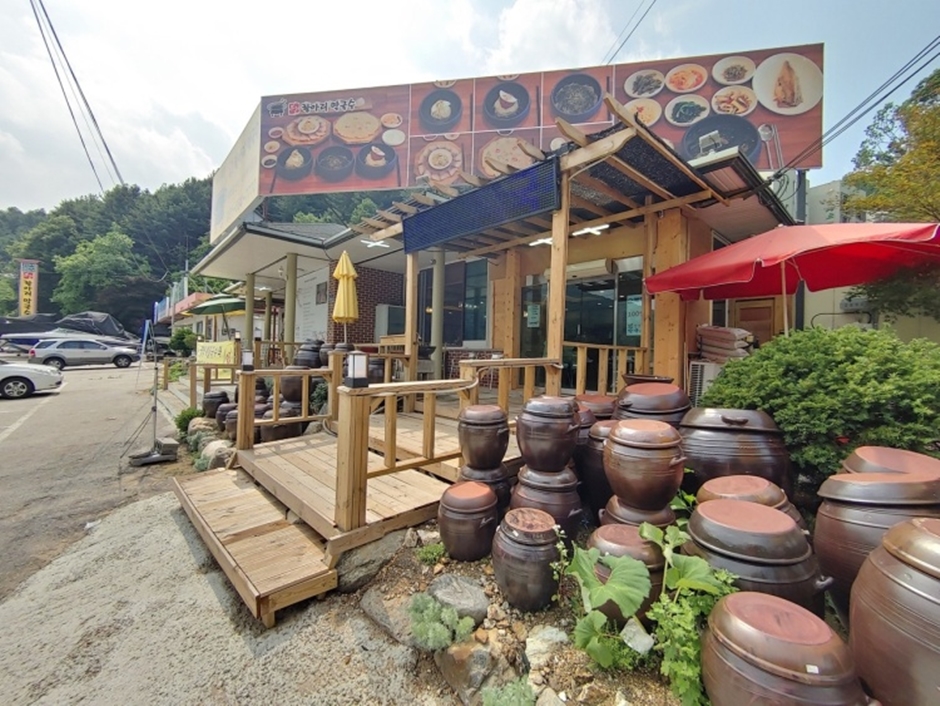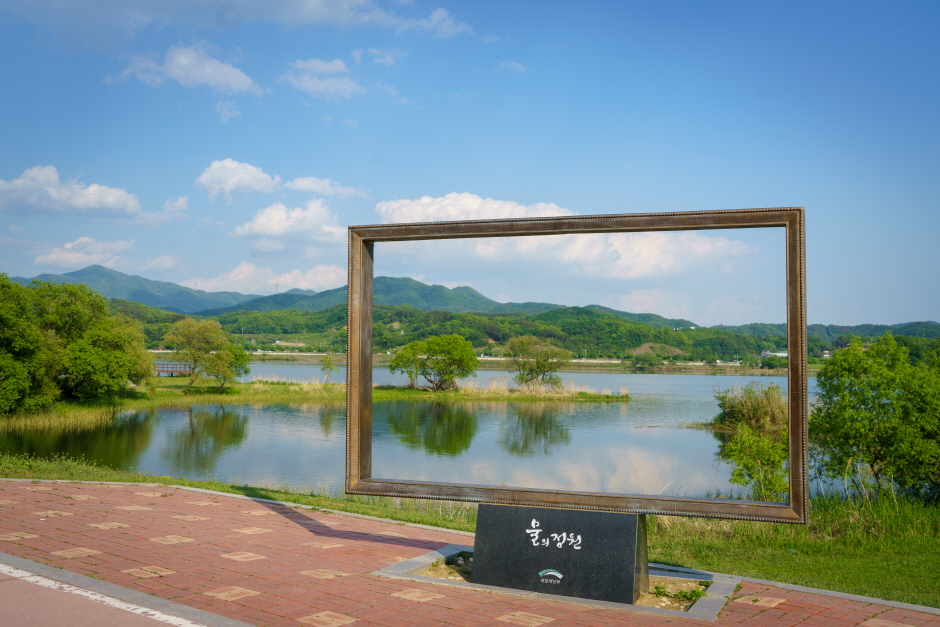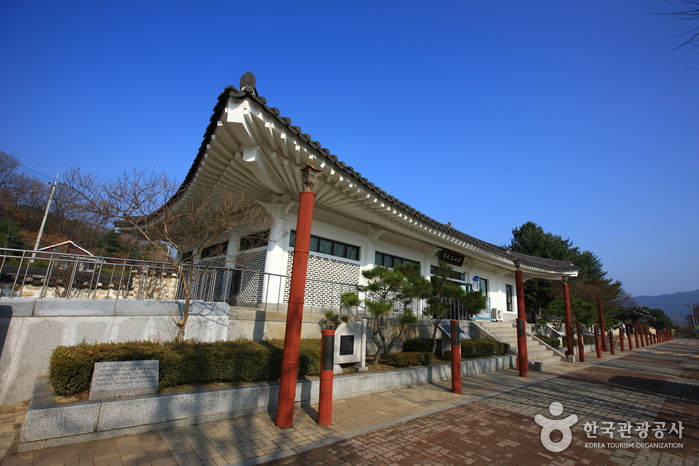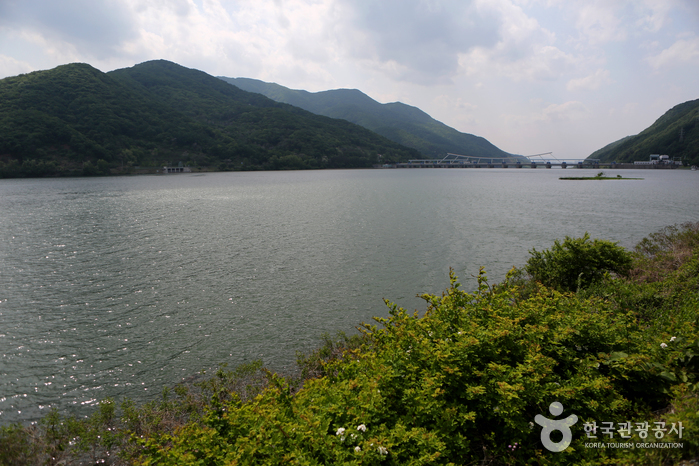Café Rino (카페리노)
18.3 Km 0 2024-02-23
32-1 Yangsu-ro 152beon-gil, Yangseo-myeon, Yangpyeong-gun, Gyeonggi-do
Café Rino, located with views of the Bukhangang River, serves a variety of freshly baked pastries and beverages prepared each morning. Notable items on the menu are Korean-style beverages, such as ssuklatte (mugwort latte) and Gyeongsan daechucha (Gyeongsan jujube tea). The café also grants access to a walking path along the river. Staying open until two in the morning every day, it provides visitors with the opportunity to enjoy the changing views of the Bukhangang River from day into night.
Gapyeong Naengmyeon Buson Seorak Main Branch (가평냉면 부손 설악본점)
18.4 Km 1 2024-02-19
1818-13 Yumyeong-ro, Seorak-myeon, Gapyeong-gun, Gyeonggi-do
Gapyeong Naengmyeon Buson is renowned for its Pyeongyang-style memil guksu (buckwheat noodles) served in a light, clear broth. The restaurant's signature dish is the siraegi deulgireum makguksu (buckwheat noodles with dried radish leaf and perilla oil). Siraegi, made from dried cabbage leaves or radish leaves, are rich in vitamins. When placed on top of memil myeon (buckwheat noodles) and mixed with deulgireum (perilla oil) and soy sauce seasoning, it creates a uniquely delightful flavor. Complementing this dish are side servings of yeolmu kimchi (young summer radish kimchi) and tangy mujeorim (pickled radish). Additionally, their gamja jeon (potato pancake) is noteworthy for its savory taste and crispy texture.
Water Garden (물의정원)
18.9 Km 3 2023-07-27
398 , Bukhangang-ro, Namyangju-si, Gyeonggi-do
Namyangju Water Garden was created as a waterside ecological park with a vast area of 484,188 ㎡ created by the Ministry of Land, Infrastructure, and Transport as part of the Hangang River Restoration Project in 2012. For residents living nearby, the water garden is a neighborhood park visited to enjoy jogging and riding along the promenade and bicycle path. It is also a great tourist destination for travelers.
Namyangju Joan [Slow City] (남양주 조안)
19.0 Km 8295 2020-03-27
413, Bukhangang-ro, Namyangju-si, Gyeonggi-do
82-31-521-5686
The origin of the city name, Joan, comes from the meaning "a place where birds dwell peacefully." Joan-myeon in Namyangju was designated a "slow city" in 2010 and was the first slow city in the Seoul metropolitan area. The city has a well-paved bike road along the Namhangang Riverbank connecting Paldang to Yangpyeong through Daeseong-ri. The city also has the Slow City Trail, starting from Ungilsan Station and passing through Majinsanseong Fortress and Sujongsa Temple before arriving at Songchon Independence Park.
Each of the twelve villages in Namyangju is known for a different local treasure, ranging from lotus fields to cultural heritages. Joan-myeon in particular has received compliments for its local communities, eco-friendly and organic farming, natural environment, traditional culture, and well-managed fisheries.
Gamnamu Jip (감나무집)
19.2 Km 27225 2024-02-28
45 Dasan-ro 747beon-gil, Joan-myeon, Namyangju-si, Gyeonggi-do
Gamnamu Jip, known for its grilled eel dishes, offers a dining experience with views of Paldangho Lake. In addition to grilled eel, they also serve megi maeuntang (spicy catfish stew) and dakbokkeumtang (spicy braised chicken). Nearby attractions include the Birth Home of Jeong Yagyong, commemorating a Silhak scholar during the late Joseon dynasty, and the the Museum of Silhak, which showcases the reform-minded academic trends of that era. The area is ideal for a pleasant stroll along the Dasan Trail and around the Paldangho Lake following a meal.
Dasan Heritage Site (Namyangju) (다산유적지 (남양주))
19.6 Km 15013 2023-06-27
11, Dasan-ro 747beon-gil, Joan-myeon, Namyangju-si, Gyeonggi-do
+82-31-590-2837
Dasan Heritage Site is located in the hometown of Dasan Jeong Yak-Yong (1762~1836), a scholar from the late Joseon Dynasty. Growing up in the village, Dasan criticized corruption, and tried to reform outdated institutions and conventions. During his long exile, Dasan authored "Mongminsimseo" (a book on how to rule the people) and "Gyeongseyupo" (a book on how to reform land policies, stabilize people's lives, and strengthen the nation and its army) among others. Today, Dasan is regarded as one of the greatest scholars of Silhak (Realist school of Confucianism) of the late Joseon dynasty.
At Dasan Heritage Site, Dasan's birthplace, Yeoyudang, grave and works are well preserved. Dasan Memorial showcases the scholar's achievements and footprints such as Geojunggi, a traditional equipment used to lift heavy objects in the Suwon Fortress construction, and the miniature Gangjin Dasan Chodang, where he lived in exile. Dasan Cultural Center houses Dasan's numerous writings and books.
Nuengnae Station [Discontinued Station] (능내역 폐역)
19.9 Km 0 2023-06-22
566-5 , Dasan-ro, Namyangju-si, Gyeonggi-do
Neungnae Station, located in Namyangju, was discontinued in November 2008 with the opening of Ungilsan Station. The station has been maintained as a monument, with some of the train tracks still in place. A bicycle path in front of the station connects Neungnae Station with the nearby Dasan Historic Site.
Paldangho Lake (팔당호)
20.0 Km 10349 2021-05-25
Namjong-myeon, Gwangju-si, Gyeonggi-do
+82-31-760-2000
Paldangho, a man-made lake, lies beside the townships of Toechon-myeon and Namjong-myeon in Gwangju-si, Gyeonggi-do. Completed in 1973, this reservoir stores approximately 250 million tons of water, which is supplied to the Seoul and Gyeonggi regions. It is also one of Gwangju's tourist attractions, offering an inspiring view and a scenic lakeside drive. Don’t miss a stop at the Paldang Observatory for a breathtaking view of Paldangho Lake.


![Namyangju Joan [Slow City] (남양주 조안)](http://tong.visitkorea.or.kr/cms/resource/61/1720461_image2_1.jpg)

![Nuengnae Station [Discontinued Station] (능내역 폐역)](http://tong.visitkorea.or.kr/cms/resource/13/2724113_image2_1.jpg)

 English
English
 한국어
한국어 日本語
日本語 中文(简体)
中文(简体) Deutsch
Deutsch Français
Français Español
Español Русский
Русский